what is the importance of protists to humans
Protists
119 Ecology of Protists
Learning Objectives
By the terminate of this department, you will be able to do the post-obit:
- Draw the role that protists play in the ecosystem
- Describe of import pathogenic species of protists
Protists function in various ecological niches. Whereas some protist species are essential components of the food chain and generators of biomass, others role in the decomposition of organic materials. Still other protists are dangerous human pathogens or causative agents of devastating plant diseases.
Primary Producers/Food Sources
Protists are essential sources of nutrient and provide diet for many other organisms. In some cases, as with zooplankton, protists are consumed directly. Alternatively, photosynthetic protists serve equally producers of nutrition for other organisms. Paramecium bursaria and several other species of ciliates are mixotrophic due to a symbiotic relationship with green algae. This is a temporary version of the secondarily endosymbiotic chloroplast plant in Euglena. Simply these symbiotic associations are not restricted to protists. For instance, photosynthetic dinoflagellates called zooxanthellae provide nutrients for the coral polyps ((Effigy)) that house them, giving corals a boost of energy to secrete their calcium carbonate skeleton. In plough, the corals provide the protist with a protected environment and the compounds needed for photosynthesis. This type of symbiotic human relationship is of import in nutrient-poor environments. Without dinoflagellate symbionts, corals lose algal pigments in a process chosen coral bleaching, and they somewhen dice. This explains why reef-building corals typically practise non reside in waters deeper than xx meters: insufficient calorie-free reaches those depths for dinoflagellates to photosynthesize.
Coral with symbiotic dinoflagellates. Coral polyps obtain nutrition through a symbiotic human relationship with dinoflagellates.
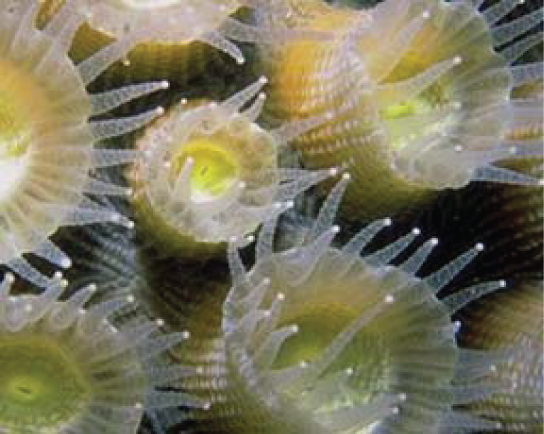
The protists and their products of photosynthesis are essential—directly or indirectly—to the survival of organisms ranging from bacteria to mammals ((Effigy)). As primary producers, protists feed a big proportion of the world's aquatic species. (On land, terrestrial plants serve as primary producers.) In fact, approximately 25 percent of the world's photosynthesis is conducted by photosynthetic protists, peculiarly dinoflagellates, diatoms, and multicellular algae.
Protists contribute to the food concatenation. About all aquatic organisms depend directly or indirectly on protists for food. (credit "mollusks": modification of work by Craig Stihler, USFWS; credit "crab": modification of work by David Berkowitz; credit "dolphin": modification of work by Mike Baird; credit "fish": modification of work past Tim Sheerman-Chase; credit "penguin": modification of work by Aaron Logan)
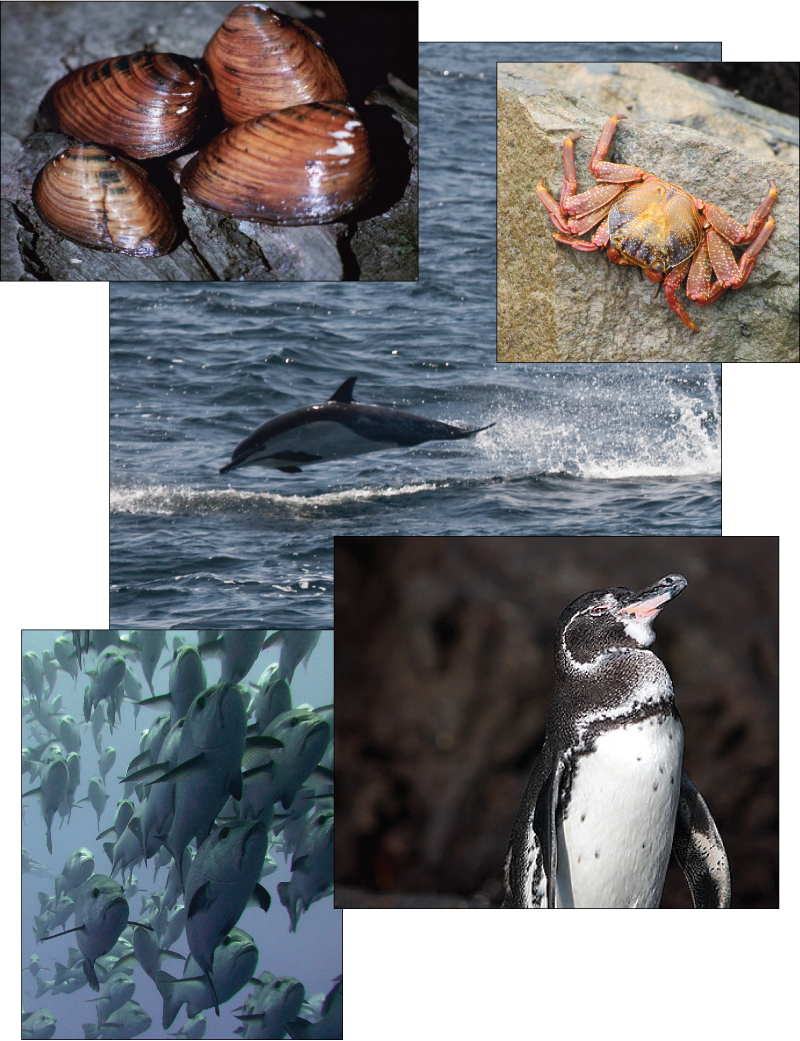
Protists do not create food sources only for sea-dwelling organisms. Recall that sure anaerobic parabasalid species be in the digestive tracts of termites and woods-eating cockroaches, where they contribute an essential stride in the digestion of cellulose ingested by these insects as they eat wood.
Human Pathogens
Every bit nosotros accept seen, a pathogen is anything that causes affliction. Parasitic organisms alive in or on a host organism and harm the organism. A small number of protists are serious pathogenic parasites that must infect other organisms to survive and propagate. For instance, protist parasites include the causative agents of malaria, African sleeping sickness, amoebic encephalitis, and waterborne gastroenteritis in humans. Other protist pathogens prey on plants, effecting massive destruction of food crops.
Plasmodium Species
In 2015 WHO reported over 200 million cases of malaria, mostly in Africa, Due south America, and south asia. However, information technology is not well known that malaria was as well a prevalent and debilitating affliction of the Northward Central region of the United States, particularly Michigan, with its thousands of lakes and numerous swamps. Prior to the civil war, and the drainage of many swamps, well-nigh everyone who immigrated to Michigan picked up malaria (ague as it was chosen in the late 1800s), and the pale, sallow, bloated faces of that period were the rule. The only salubrious faces were worn past those immigrants who had just arrived. In fact, there were more deaths due to malaria in Michigan than those from the Ceremonious War.
We at present know that malaria is caused by several species of the apicomplexan protist genus Plasmodium. Members of Plasmodium must sequentially require both a musquito and a vertebrate to complete their life wheel. In vertebrates, the parasite develops in liver cells (the exoerythrocytic stage) and goes on to infect ruby blood cells (the erythrocytic stage), bursting from and destroying the blood cells with each asexual replication bicycle ((Figure)). Of the four Plasmodium species known to infect humans, P. falciparum accounts for 50 percentage of all malaria cases and is the chief (and deadliest) cause of disease-related fatalities in tropical regions of the world. In 2015, it was estimated that malaria caused over 400,000 deaths, mostly in African children. During the course of malaria, P. falciparum tin infect and destroy more than i-half of a human's circulating blood cells, leading to severe anemia. In response to waste matter products released as the parasites flare-up from infected claret cells, the host immune system mounts a massive inflammatory response with episodes of delirium-inducing fever (paroxysms) as parasites lyse ruby claret cells, spilling parasite waste product into the bloodstream. P. falciparum is transmitted to humans past the African musquito, Anopheles gambiae. Techniques to kill, sterilize, or avoid exposure to this highly aggressive musquito species are crucial to malaria command. Ironically, a type of genetic control has arisen in parts of the world where malaria is endemic. Possession of ane copy of the HbS beta globin allele results in malaria resistance. Unfortunately, this allele also has an unfortunate second event; when homozygous it causes sickle cell disease.
Malaria parasite. Red claret cells are shown to exist infected with P. falciparum, the causative amanuensis of malaria. In this calorie-free microscopic image taken using a 100× oil immersion lens, the ring-shaped P. falciparum stains royal. (credit: modification of work by Michael Zahniser; scale-bar data from Matt Russell)
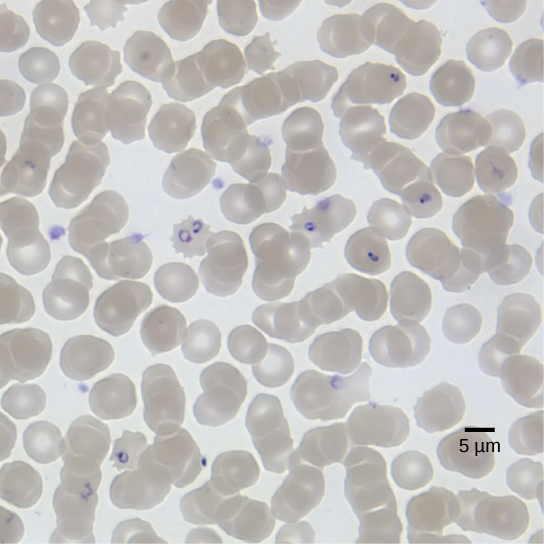
Link to Learning
This movie depicts the pathogenesis of Plasmodium falciparum, the causative amanuensis of malaria.
Trypanosomes
Trypanosoma brucei ((Effigy)), transmitted by tsetse flies (Glossina spp) in Africa, and related flies in South America, is an flagellated endoparasite responsible for the deadly disease nagana in cattle and horses, and for African sleeping sickness in humans. This trypanosome confounds the homo immune organisation by changing its thick layer of surface glycoproteins with each infectious cycle. (The glycoproteins are identified by the immune system every bit foreign antigens, and a specific antibody defense is mounted against the parasite.) However, T. brucei has thousands of possible antigens, and with each subsequent generation, the protist switches to a glycoprotein coating with a different molecular structure. In this way, T. brucei is capable of replicating continuously without the immune system e'er succeeding in immigration the parasite. Without treatment, T. brucei attacks cherry blood cells, causing the patient to lapse into a coma and somewhen die. During epidemic periods, mortality from the disease tin be high. Greater surveillance and command measures lead to a reduction in reported cases; some of the lowest numbers reported in 50 years (fewer than 10,000 cases in all of sub-Saharan Africa) have happened since 2009.
Link to Learning
This motion picture discusses the pathogenesis of Trypanosoma brucei, the causative agent of African sleeping sickness.
In Latin America, another species of trypanosome, T. cruzi, is responsible for Chagas disease. T. cruzi infections are mainly caused past a blood-sucking "kissing bug" in the genus Triatoma. These "truthful bugs" bite the host during the night and and so defecate on the wound, transmitting the trypanosome to the victim. The victim scratches the wound, further inoculating the site with trypanosomes at the location of the bite. After nearly 10 weeks, individuals enter the chronic phase but nigh never develop further symptoms. In about 30 pct of cases, yet, the trypanosome causes farther damage, especially to the heart and digestive system tissues in the chronic phase of infection, leading to malnutrition and middle failure due to abnormal heart rhythms. An estimated x million people are infected with Chagas disease, and it caused x,000 deaths in 2008.
Trypanosomes. Trypanosomes are shown among red blood cells. (credit: modification of piece of work by Dr. Myron G. Shultz; scale-bar data from Matt Russell)
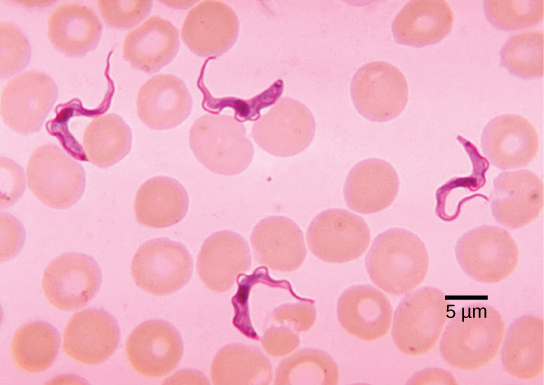
Plant Parasites
Protist parasites of terrestrial plants include agents that destroy nutrient crops. The oomycete Plasmopara viticola parasitizes grape plants, causing a illness called downy mildew ((Figure)). Grape plants infected with P. viticola announced stunted and take discolored, withered leaves. The spread of downy mildew nearly collapsed the French wine industry in the nineteenth century.
Protist plant infections. Both featherlike and powdery mildews on this grape leaf are caused by an infection of P. viticola. (credit: modification of work by USDA)
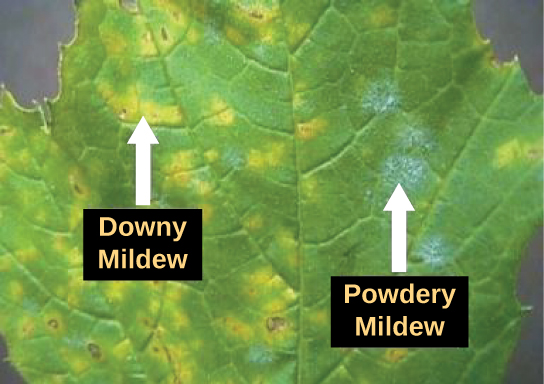
Phytophthora infestans is an oomycete responsible for tater belatedly bane, which causes white potato stalks and stems to disuse into black slime ((Figure)). Widespread spud blight caused past P. infestans precipitated the well-known White potato dearth in the nineteenth century that claimed the lives of approximately 1 one thousand thousand people and led to the emigration of at least 1 one thousand thousand more from Ireland. Late blight continues to plague potato crops in certain parts of the U.s.a. and Russian federation, wiping out as much every bit lxx percent of crops when no pesticides are applied.
Potato bane. These unappetizing remnants effect from an infection with P. infestans, the causative agent of potato late blight. (credit: USDA)
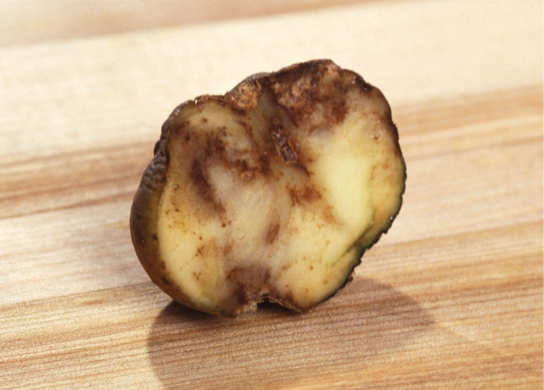
Protist Decomposers
The mucus-like protist saprobes are specialized to absorb nutrients from nonliving organic thing, such as dead organisms or their wastes. For instance, many types of oomycetes grow on dead animals or algae. Saprobic protists have the essential function of returning inorganic nutrients to the soil and water. This process allows for new institute growth, which in turn generates sustenance for other organisms along the food chain. Indeed, without saprobe species, such every bit protists, fungi, and bacteria, life would finish to be as all organic carbon became "tied upward" in dead organisms.
Department Summary
Protists office at several levels of the ecological nutrient web: as master producers, as direct nutrient sources, and as decomposers. In addition, many protists are parasites of plants and animals and can crusade mortiferous homo diseases or destroy valuable crops.
Review Questions
An example of carbon fixation is _____________.
- photosynthesis
- decomposition
- phagocytosis
- parasitism
A
Which parasitic protist evades the host immune organization by altering its surface proteins with each generation?
- Paramecium caudatum
- Trypanosoma brucei
- Plasmodium falciparum
- Phytophthora infestans
B
Which of the post-obit is non a way that protists contribute to the food web?
- They prepare carbon into organic molecules.
- They occupy the noon producer niche.
- They enter symbiotic relationships with animals.
- They recycle nutrients back into the carbon and nitrogen cycles.
B
Critical Thinking Questions
How does killing Anopheles mosquitoes affect the Plasmodium protists?
Plasmodium parasites infect humans and cause malaria. However, they must complete part of their life bike within Anopheles mosquitoes, and they tin can only infect humans via the bite wound of a musquito. If the mosquito population is decreased, then fewer Plasmodium would be able to develop and infect humans, thereby reducing the incidence of human infections with this parasite.
Without treatment, why does African sleeping sickness invariably lead to death?
The trypanosomes that cause this disease are capable of expressing a glycoprotein coat with a different molecular structure with each generation. Because the immune arrangement must respond to specific antigens to heighten a meaningful defense, the changing nature of trypanosome antigens prevents the allowed system from ever clearing this infection. Massive trypanosome infection eventually leads to host organ failure and expiry.
Depict how increasing stress to the sea would affect a food chain containing zooxanthellae, corals, parrotfish, and sharks.
Ocean stresses, such as rising temperatures or increasing levels of pollution, cause corals to expel their zooxanthellae symbionts. This leads to coral bleaching, and decease if no new zoocanthellae colonize the corals. The dying corals will decrease the food source bachelor to parrotfish, then the parrotfish population volition decline. With fewer prey animals available, the shark population in the area will also reject.
Source: https://opentextbc.ca/biology2eopenstax/chapter/ecology-of-protists/
Enregistrer un commentaire for "what is the importance of protists to humans"